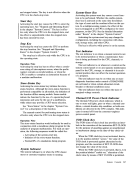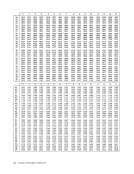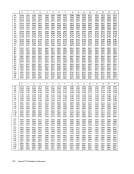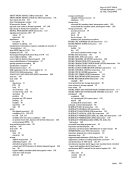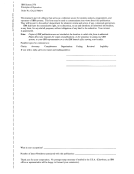Operator Section Address-Compare Controls. Check-Stop Indicator .
Configuration Controls.
Display-and-Enter Controls.
Emergency-PullSwitch. Enable-System-Clear Key I MPL Controls Interrupt Key
LoadIndicator Load Key.
Load-Unit-AddressControls Manual Indicator Power-Off Key
Power-On Key
RateControl. Restart Key Start Key. Stop Key. Store-Status Key System Indicator System-Reset Key
TestIndicator Contents
Thermal/CB Power-CheckIndicator TOO Clock Key .
WaitIndicator Remote Operator-Control Panel
Customer-EngineerSection The system console provides the functions necessary
to operate and control the system. It consists of the
system control panel and, in most cases, an associat
ed console device, which may be used either as anI/O device or as a manual display-and-enter device.
The system console may be implemented in various
technologies and configurations; however, certain
functions are basic to all models.
The system-control-panel part of the system con
sole contains an operator section and a customer
engineer section.
The operator section provides a means for the
control and indication of power, the indication of
system status, operator-to-system communication,
the control of time-of-day clock security, initial pro
gram loading, resets, and other controls required by
the operator for intervening in normal programmed
operation. It may include controls used for loading
microprograms into reloadable control storage and
for loading resident diagnostic programs.
The customer-engineer section includes controls
intended only for customer-engineer use. Additional
customer-engineer controls may be available on the
main-storage and channel frames.
System Console
243
244
245
245
245
245
245
245
245
245
245
246
246
246
246
246
246
247
247
247
247
247
247
247
247
248
248
248
The console device, when used as anI/O device,
provides a means of communicating control informa
tion and of entering and displaying text. Implemen
tation of this device is model-dependent; thedevice typically may be a keyboard and an associated print
er or cathode-ray tube (CRT).
The specific console device provided on a paiticu
lar model ofSystem/370 is described in the Systems
Reference Library (SRL) and System Library (SL)
publications for that model.
Operator Section
The operator section contains the basic controls
required by the operator and the controls required
by the operator for intervening in normal programmed
operation. These controls may be interspersed
with customer-engineer controls and may, depending
on the model, contain switch positions and nomen
clature additional to those described here.
Machine errors detected during manual opera
tions do not cause an immediate interruption or log
out but may, in some cases, create a pending
machine-check-interruption condition. This interrup
tion request, unless it is removed by the use of a
System Console 243
Configuration Controls.
Display-and-Enter Controls.
Emergency-Pull
Load
Load-Unit-Address
Power-On Key
Rate
Test
Thermal/CB Power-Check
Wait
Customer-Engineer
to operate and control the system. It consists of the
system control panel and, in most cases, an associat
ed console device, which may be used either as an
The system console may be implemented in various
technologies and configurations; however, certain
functions are basic to all models.
The system-control-panel part of the system con
sole contains an operator section and a customer
engineer section.
The operator section provides a means for the
control and indication of power, the indication of
system status, operator-to-system communication,
the control of time-of-day clock security, initial pro
gram loading, resets, and other controls required by
the operator for intervening in normal programmed
operation. It may include controls used for loading
microprograms into reloadable control storage and
for loading resident diagnostic programs.
The customer-engineer section includes controls
intended only for customer-engineer use. Additional
customer-engineer controls may be available on the
main-storage and channel frames.
System Console
243
244
245
245
245
245
245
245
245
245
245
246
246
246
246
246
246
247
247
247
247
247
247
247
247
248
248
248
The console device, when used as an
provides a means of communicating control informa
tion and of entering and displaying text. Implemen
tation of this device is model-dependent; the
er or cathode-ray tube (CRT).
The specific console device provided on a paiticu
lar model of
Reference Library (SRL) and System Library (SL)
publications for that model.
Operator Section
The operator section contains the basic controls
required by the operator and the controls required
by the operator for intervening in normal programmed
operation. These controls may be interspersed
with customer-engineer controls and may, depending
on the model, contain switch positions and nomen
clature additional to those described here.
Machine errors detected during manual opera
tions do not cause an immediate interruption or log
out but may, in some cases, create a pending
machine-check-interruption condition. This interrup
tion request, unless it is removed by the use of a
System Console 243
























































































































































































































































